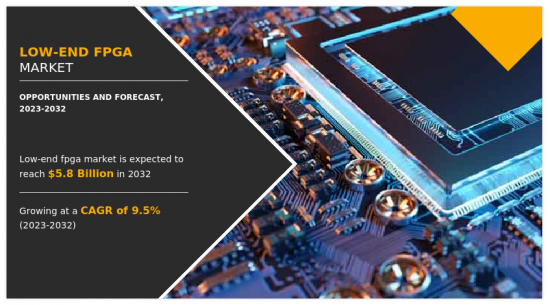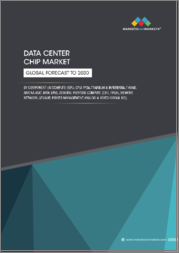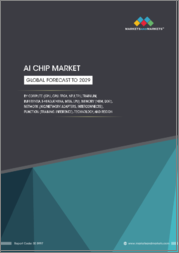
|
시장보고서
상품코드
1365651
로엔드 FPGA 시장 : 기술별, 노드 사이즈별, 용도별 - 세계 기회 분석과 산업 예측(2023-2032년)Low-End FPGA Market By Technology, By Node Size, By Application : Global Opportunity Analysis and Industry Forecast, 2023-2032 |
||||||
로엔드 FPGA 시장은 2022년에 24억 달러로 평가되며, 2023-2032년 CAGR 9.5%로 성장하며, 2032년에는 58억 달러에 달할 것으로 예측되고 있습니다.

로엔드 FPGA는 저전력 소비, 낮은 로직 밀도, 칩당 복잡성을 최소화하기 위해 설계된 필드 프로그래머블 게이트 어레이입니다. 로엔드 FPGA는 하이엔드 FPGA보다 비용이 저렴하며, 자동차, 가전제품, 산업 용도 등 다양한 산업 분야에서 사용되고 있습니다. 자동차 분야에서 로엔드 FPGA는 ADAS(첨단 운전자 보조 시스템), 인포테인먼트 시스템, 엔진 제어, 차체 제어, 보안 등의 용도에 적용되고 있습니다.
세계 로엔드 FPGA 시장의 성장을 주도하는 것은 비용 효율성입니다. 로엔드 FPGA는 하이엔드 FPGA에 비해 가격이 저렴하기 때문에 다양한 고객이 이용할 수 있습니다. 이러한 경제성 덕분에 로엔드 FPGA는 프로그래머블 로직 기능이 필요하지만 예산이 제한적인 다양한 산업 및 용도에 매력적인 제품입니다. 또한 로엔드 FPGA는 저전력 소비, 소형 사이즈, 실시간 데이터 처리 능력으로 엣지 컴퓨팅에 이상적인 플랫폼을 제공합니다. 엣지에서의 인공지능(AI) 용도이 부상함에 따라 로엔드 FPGA는 리소스가 제한된 환경에서 효율적인 AI 추론과 데이터 분석을 구현하는 데 중요한 역할을 합니다. 그러나 로엔드 FPGA의 확장성과 업그레이드 가능성은 한계가 있으므로 향후 시스템의 성장과 확장에 대응하는 데 어려움을 겪을 수 있으며, 이는 완전한 재설계나 고성능 플랫폼으로의 전환을 요구할 수 있습니다.
저가형 FPGA의 주요 목표는 중간 정도의 복잡성과 낮은 성능을 필요로 하는 용도을 위한 비용 효율적이고 적응성이 높은 하드웨어 솔루션을 제공하는 것입니다. 이 FPGA는 기능, 리소스 사용률 및 가격의 균형을 이루며 프로토타이핑, 임베디드 시스템, 신호 처리, 통신, 교육 및 취미 프로젝트에 이상적입니다. 또한 로엔드 FPGA 칩은 산업 자동화 및 로봇 공학에서 실시간 제어, 센서 인터페이스, 데이터 처리 등에 사용됩니다. 이러한 장비는 복잡한 알고리즘, 통신 프로토콜 및 프로그래밍 가능한 논리 회로를 설치하여 자동화 시스템의 성능, 정확성 및 효율성을 향상시키고 생산 및 운영 능력을 향상시킵니다.
로엔드 FPGA 시장은 노드 크기, 기술, 용도, 지역별로 구분됩니다. 노드 크기별로는 28nm 미만, 28-90nm, 90nm 이상으로 나뉩니다. 기술별로는 EEPROM, SRAM, 안티퓨즈, 플래시, 기타로 분류됩니다. 용도별로는 통신, 자동차, 산업, 가전, 데이터센터, 헬스케어, 항공우주 및 방위, 기타로 분류됩니다.
지역별로는 북미(미국, 캐나다, 멕시코), 유럽(영국, 독일, 프랑스, 기타 유럽), 아시아태평양(중국, 일본, 인도, 한국, 기타 아시아태평양), 중남미(중남미, 중동 및 아프리카), 라틴아메리카(중남미, 중동 및 아프리카)로 나누어 분석하였습니다.
- 이 보고서는 Enclustra, Intel Corporation, Efinix, Inc. Devices, Inc., Gowin Semiconductor Corp., QuickLogic Corporation, Microchip Technology Inc. 로엔드 FPGA 시장의 주요 기업을 소개합니다. 시장 진출기업은 로엔드 FPGA 시장에서 발판을 마련하기 위해 제품 출시, 인수 등 다양한 전략을 채택하고 있습니다.
- 주요 시장 세분화
목차
제1장 서론
제2장 주요 요약
제3장 시장 개요
- 시장의 정의와 범위
- 주요 조사 결과
- 영향요인
- 주요 투자 기회
- Porter's Five Forces 분석
- 시장 역학
- 촉진요인
- 전 세계에서 스마트 기술의 채택이 증가
- ADAS(첨단운전자보조시스템)에서 로엔드 FGPA의 채택 증가
- 커넥티드 디바이스와 사물인터넷(IoT)의 보급
- 억제요인
- 높은 소비전력
- 기회
- 보급률의 상승과 기술의 진보
- 촉진요인
- COVID-19 시장에 대한 영향 분석
제4장 로엔드 FPGA 시장 : 기술별
- 개요
- EEPROM
- 안티 퓨즈
- SRAM
- 플래시
- 기타
제5장 로엔드 FPGA 시장 : 노드 사이즈별
- 개요
- 28 nm미만
- 28-90나노미터
- 90 nm이상
제6장 로엔드 FPGA 시장 : 애플리케이션별
- 개요
- 통신
- 자동차
- 산업용
- 가전
- 데이터센터
- 의료
- 항공우주·방위
- 기타
제7장 로엔드 FPGA 시장 : 지역별
- 개요
- 북미
- 미국
- 캐나다
- 멕시코
- 유럽
- 영국
- 독일
- 프랑스
- 기타
- 아시아태평양
- 중국
- 일본
- 인도
- 한국
- 기타
- 라틴아메리카
- 라틴아메리카
- 중동
- 아프리카
제8장 경쟁 구도
- 서론
- 주요 성공 전략
- 주요 10사의 제품 매핑
- 경쟁 대시보드
- 경쟁 히트맵
- 주요 기업의 포지셔닝, 2022년
제9장 기업 개요
- Enclustra.
- Intel Corporation.
- Efinix, inc.
- FlexLogix
- Achronix semiconductor corporation
- Advanced Micro Devices, Inc.
- GOWIN Semiconductor Corp.
- QuickLogic Corporation
- Microchip Technology Inc.
- Lattice Semiconductor Corporation
According to a new report published by Allied Market Research, titled, "Low-End FPGA Market," The low-end fpga market was valued at $2.4 billion in 2022, and is estimated to reach $5.8 billion by 2032, growing at a CAGR of 9.5% from 2023 to 2032.

A low-end FPGAs is a field-programmable gate array designed for low power consumption, low logic density, and minimal complexity per chip. Low-end FPGAs cost less than high-end FPGAs and are employed in a variety of industries, including automotive, consumer electronics, and industrial applications. In the automotive sector, low-end FPGAs are employed in applications such as advanced driver assistance systems (ADAS), infotainment systems, engine control, body control, and security.
The growth of the global low-end FPGAs market is driven by cost-effectiveness. Low-end FPGAs are affordable compared to their high-end counterparts, making them accessible to a broader range of customers. This affordability makes low-end FPGAs attractive to various industries and applications that require programmable logic capabilities but have budget constraints. Further, low-end FPGAs provide an ideal platform for edge computing due to their low power consumption, compact size, and ability to handle real-time data processing. With the rise of artificial intelligence (AI) applications at the edge, low-end FPGAs can play a vital role in enabling efficient AI inference and data analytics in resource-constrained environments. However, the limited scalability and upgradeability of low-end FPGAs can pose challenges in accommodating the future growth and enhancements of the systems, potentially requiring a complete redesign or migration to more capable platforms.
The primary goal of low-end FPGAs is to provide a cost-effective and adaptable hardware solution for applications requiring moderate complexity and lower performance. These FPGAs strike a mix between functionality, resource utilization, and price, making them ideal for prototyping, embedded systems, signal processing, communication, education, and hobbyist projects. Furthermore, low-end FPGAs chips are used in industrial automation and robotics for activities such as real-time control, sensor interface, and data processing. These devices allow for the installation of complicated algorithms, communication protocols, and programmable logic circuits to improve the performance, precision, and efficiency of automated systems, resulting in increased production and operational capabilities.
The low-end FPGAs market is segmented on the basis of node size, technology, application, and region. By node size, the market is divided into Less than 28 nm, 28-90 nm, and more than 90 nm. By technology, the market is categorized into EEPROM, SRAM, anti-fuse, flash, and others. By application, the market is segmented into telecommunication, automotive, industrial, consumer electronics, data center, healthcare, aerospace & defense, and others.
By region, it is analyzed across North America (the U.S., Canada, and Mexico), Europe (UK, Germany, France, and rest of Europe), Asia-Pacific (China, Japan, India, South Korea, and rest of Asia-Pacific), and LAMEA (Latin America, the Middle East, and Africa).
- The key players profiled in the Low-end FPGAs market, such as Enclustra, Intel Corporation, Efinix, Inc., Flex Logix Technologies, Inc., Achronix Semiconductor Corporation, Advanced Micro Devices, Inc, Gowin Semiconductor Corp., QuickLogic Corporation, Microchip Technology Inc., Lattice Semiconductor Corporation are provided in this report. Market players have adopted various strategies such as product launch, and acquisition, to expand their foothold in the low-end FPGA market.
- Key market segments
By Technology
- EEPROM
- Anti-Fuse
- SRAM
- Flash
- Others
By Node Size
- Less Than 28 nm
- 28-90 nm
- More Than 90 nm
By Application
- Telecommunication
- Automotive
- Industrial
- Consumer electronics
- Data Center
- Medical
- Aerospace and Defense
- Others
By Region
- North America
- U.S.
- Canada
- Mexico
- Europe
- UK
- Germany
- France
- Rest of Europe
- Asia-Pacific
- China
- Japan
- India
- South Korea
- Rest of Asia-Pacific
- LAMEA
- Latin America
- Middle East
- Africa
KEY MARKET PLAYERS PROFILED IN THE REPORT
- ENCLUSTRA.
- INTEL CORPORATION.
- EFINIX, INC.
- FLEXLOGIX
- ACHRONIX SEMICONDUCTOR CORPORATION
- ADVANCED MICRO DEVICES, INC.
- GOWIN SEMICONDUCTOR CORP.
- QUICKLOGIC CORPORATION
- MICROCHIP TECHNOLOGY INC.
- LATTICE SEMICONDUCTOR CORPORATION
Key Benefits For Stakeholders
- This report provides a quantitative analysis of the market segments, current trends, estimations, and dynamics of the low-end fpga market analysis from 2022 to 2032 to identify the prevailing low-end fpga market opportunities.
- The market research is offered along with information related to key drivers, restraints, and opportunities.
- Porter's five forces analysis highlights the potency of buyers and suppliers to enable stakeholders make profit-oriented business decisions and strengthen their supplier-buyer network.
- In-depth analysis of the low-end fpga market segmentation assists to determine the prevailing market opportunities.
- Major countries in each region are mapped according to their revenue contribution to the global market.
- Market player positioning facilitates benchmarking and provides a clear understanding of the present position of the market players.
- The report includes the analysis of the regional as well as global low-end fpga market trends, key players, market segments, application areas, and market growth strategies.
Additional benefits you will get with this purchase are:
- Quarterly Update and* (only available with a corporate license, on listed price)
- 5 additional Company Profile of client Choice pre- or Post-purchase, as a free update.
- Free Upcoming Version on the Purchase of Five and Enterprise User License.
- 16 analyst hours of support* (post-purchase, if you find additional data requirements upon review of the report, you may receive support amounting to 16 analyst hours to solve questions, and post-sale queries)
- 15% Free Customization* (in case the scope or segment of the report does not match your requirements, 20% is equivalent to 3 working days of free work, applicable once)
- Free data Pack on the Five and Enterprise User License. (Excel version of the report)
- Free Updated report if the report is 6-12 months old or older.
- 24-hour priority response*
- Free Industry updates and white papers.
Possible Customization with this report (with additional cost and timeline talk to the sales executive to know more)
- Product Life Cycles
- Market share analysis of players by products/segments
- New Product Development/ Product Matrix of Key Players
- Additional company profiles with specific to client's interest
- Additional country or region analysis- market size and forecast
- Historic market data
- Key player details (including location, contact details, supplier/vendor network etc. in excel format)
- Market share analysis of players at global/region/country level
- SWOT Analysis
Key Market Segments
By Technology
- EEPROM
- Antifuse
- SRAM
- Flash
- Others
By Node Size
- Less Than 28 nm
- 28-90 nm
- More Than 90 nm
By Application
- Telecommunication
- Automotive
- Industrial
- Consumer electronics
- Data Center
- Medical
- Aerospace and Defense
- Others
By Region
- North America
- U.S.
- Canada
- Mexico
- Europe
- UK
- Germany
- France
- Rest of Europe
- Asia-Pacific
- China
- Japan
- India
- South Korea
- Rest of Asia-Pacific
- LAMEA
- Latin America
- Middle East
- Africa
Key Market Players:
- Achronix semiconductor corporation
- Advanced Micro Devices, Inc.
- Efinix, inc.
- Enclustra.
- FlexLogix
- GOWIN Semiconductor Corp.
- Intel Corporation.
- Lattice Semiconductor Corporation
- Microchip Technology Inc.
- QuickLogic Corporation
TABLE OF CONTENTS
CHAPTER 1: INTRODUCTION
- 1.1. Report description
- 1.2. Key market segments
- 1.3. Key benefits to the stakeholders
- 1.4. Research Methodology
- 1.4.1. Primary research
- 1.4.2. Secondary research
- 1.4.3. Analyst tools and models
CHAPTER 2: EXECUTIVE SUMMARY
- 2.1. CXO Perspective
CHAPTER 3: MARKET OVERVIEW
- 3.1. Market definition and scope
- 3.2. Key findings
- 3.2.1. Top impacting factors
- 3.2.2. Top investment pockets
- 3.3. Porter's five forces analysis
- 3.3.1. Low to moderate bargaining power of suppliers
- 3.3.2. Moderate to high threat of new entrants
- 3.3.3. Low to moderate threat of substitutes
- 3.3.4. Low to high intensity of rivalry
- 3.3.5. Moderate bargaining power of buyers
- 3.4. Market dynamics
- 3.4.1. Drivers
- 3.4.1.1. Increase in the adoption of smart technologies across the globe
- 3.4.1.2. Rise in adoption of low-end FGPA in advanced driver assistance systems
- 3.4.1.3. Proliferation of connected devices and Internet of Things (IoT)
- 3.4.1. Drivers
- 3.4.2. Restraints
- 3.4.2.1. High power consumption
- 3.4.3. Opportunities
- 3.4.3.1. Increase in Penetration and Technological Advancements
- 3.5. COVID-19 Impact Analysis on the market
CHAPTER 4: LOW-END FPGA MARKET, BY TECHNOLOGY
- 4.1. Overview
- 4.1.1. Market size and forecast
- 4.2. EEPROM
- 4.2.1. Key market trends, growth factors and opportunities
- 4.2.2. Market size and forecast, by region
- 4.2.3. Market share analysis by country
- 4.3. Antifuse
- 4.3.1. Key market trends, growth factors and opportunities
- 4.3.2. Market size and forecast, by region
- 4.3.3. Market share analysis by country
- 4.4. SRAM
- 4.4.1. Key market trends, growth factors and opportunities
- 4.4.2. Market size and forecast, by region
- 4.4.3. Market share analysis by country
- 4.5. Flash
- 4.5.1. Key market trends, growth factors and opportunities
- 4.5.2. Market size and forecast, by region
- 4.5.3. Market share analysis by country
- 4.6. Others
- 4.6.1. Key market trends, growth factors and opportunities
- 4.6.2. Market size and forecast, by region
- 4.6.3. Market share analysis by country
CHAPTER 5: LOW-END FPGA MARKET, BY NODE SIZE
- 5.1. Overview
- 5.1.1. Market size and forecast
- 5.2. Less Than 28 nm
- 5.2.1. Key market trends, growth factors and opportunities
- 5.2.2. Market size and forecast, by region
- 5.2.3. Market share analysis by country
- 5.3. 28-90 nm
- 5.3.1. Key market trends, growth factors and opportunities
- 5.3.2. Market size and forecast, by region
- 5.3.3. Market share analysis by country
- 5.4. More Than 90 nm
- 5.4.1. Key market trends, growth factors and opportunities
- 5.4.2. Market size and forecast, by region
- 5.4.3. Market share analysis by country
CHAPTER 6: LOW-END FPGA MARKET, BY APPLICATION
- 6.1. Overview
- 6.1.1. Market size and forecast
- 6.2. Telecommunication
- 6.2.1. Key market trends, growth factors and opportunities
- 6.2.2. Market size and forecast, by region
- 6.2.3. Market share analysis by country
- 6.3. Automotive
- 6.3.1. Key market trends, growth factors and opportunities
- 6.3.2. Market size and forecast, by region
- 6.3.3. Market share analysis by country
- 6.4. Industrial
- 6.4.1. Key market trends, growth factors and opportunities
- 6.4.2. Market size and forecast, by region
- 6.4.3. Market share analysis by country
- 6.5. Consumer electronics
- 6.5.1. Key market trends, growth factors and opportunities
- 6.5.2. Market size and forecast, by region
- 6.5.3. Market share analysis by country
- 6.6. Data Center
- 6.6.1. Key market trends, growth factors and opportunities
- 6.6.2. Market size and forecast, by region
- 6.6.3. Market share analysis by country
- 6.7. Medical
- 6.7.1. Key market trends, growth factors and opportunities
- 6.7.2. Market size and forecast, by region
- 6.7.3. Market share analysis by country
- 6.8. Aerospace and Defense
- 6.8.1. Key market trends, growth factors and opportunities
- 6.8.2. Market size and forecast, by region
- 6.8.3. Market share analysis by country
- 6.9. Others
- 6.9.1. Key market trends, growth factors and opportunities
- 6.9.2. Market size and forecast, by region
- 6.9.3. Market share analysis by country
CHAPTER 7: LOW-END FPGA MARKET, BY REGION
- 7.1. Overview
- 7.1.1. Market size and forecast By Region
- 7.2. North America
- 7.2.1. Key trends and opportunities
- 7.2.2. Market size and forecast, by Technology
- 7.2.3. Market size and forecast, by Node Size
- 7.2.4. Market size and forecast, by Application
- 7.2.5. Market size and forecast, by country
- 7.2.5.1. U.S.
- 7.2.5.1.1. Key market trends, growth factors and opportunities
- 7.2.5.1.2. Market size and forecast, by Technology
- 7.2.5.1.3. Market size and forecast, by Node Size
- 7.2.5.1.4. Market size and forecast, by Application
- 7.2.5.2. Canada
- 7.2.5.2.1. Key market trends, growth factors and opportunities
- 7.2.5.2.2. Market size and forecast, by Technology
- 7.2.5.2.3. Market size and forecast, by Node Size
- 7.2.5.2.4. Market size and forecast, by Application
- 7.2.5.3. Mexico
- 7.2.5.3.1. Key market trends, growth factors and opportunities
- 7.2.5.3.2. Market size and forecast, by Technology
- 7.2.5.3.3. Market size and forecast, by Node Size
- 7.2.5.3.4. Market size and forecast, by Application
- 7.3. Europe
- 7.3.1. Key trends and opportunities
- 7.3.2. Market size and forecast, by Technology
- 7.3.3. Market size and forecast, by Node Size
- 7.3.4. Market size and forecast, by Application
- 7.3.5. Market size and forecast, by country
- 7.3.5.1. UK
- 7.3.5.1.1. Key market trends, growth factors and opportunities
- 7.3.5.1.2. Market size and forecast, by Technology
- 7.3.5.1.3. Market size and forecast, by Node Size
- 7.3.5.1.4. Market size and forecast, by Application
- 7.3.5.2. Germany
- 7.3.5.2.1. Key market trends, growth factors and opportunities
- 7.3.5.2.2. Market size and forecast, by Technology
- 7.3.5.2.3. Market size and forecast, by Node Size
- 7.3.5.2.4. Market size and forecast, by Application
- 7.3.5.3. France
- 7.3.5.3.1. Key market trends, growth factors and opportunities
- 7.3.5.3.2. Market size and forecast, by Technology
- 7.3.5.3.3. Market size and forecast, by Node Size
- 7.3.5.3.4. Market size and forecast, by Application
- 7.3.5.4. Rest of Europe
- 7.3.5.4.1. Key market trends, growth factors and opportunities
- 7.3.5.4.2. Market size and forecast, by Technology
- 7.3.5.4.3. Market size and forecast, by Node Size
- 7.3.5.4.4. Market size and forecast, by Application
- 7.4. Asia-Pacific
- 7.4.1. Key trends and opportunities
- 7.4.2. Market size and forecast, by Technology
- 7.4.3. Market size and forecast, by Node Size
- 7.4.4. Market size and forecast, by Application
- 7.4.5. Market size and forecast, by country
- 7.4.5.1. China
- 7.4.5.1.1. Key market trends, growth factors and opportunities
- 7.4.5.1.2. Market size and forecast, by Technology
- 7.4.5.1.3. Market size and forecast, by Node Size
- 7.4.5.1.4. Market size and forecast, by Application
- 7.4.5.2. Japan
- 7.4.5.2.1. Key market trends, growth factors and opportunities
- 7.4.5.2.2. Market size and forecast, by Technology
- 7.4.5.2.3. Market size and forecast, by Node Size
- 7.4.5.2.4. Market size and forecast, by Application
- 7.4.5.3. India
- 7.4.5.3.1. Key market trends, growth factors and opportunities
- 7.4.5.3.2. Market size and forecast, by Technology
- 7.4.5.3.3. Market size and forecast, by Node Size
- 7.4.5.3.4. Market size and forecast, by Application
- 7.4.5.4. South Korea
- 7.4.5.4.1. Key market trends, growth factors and opportunities
- 7.4.5.4.2. Market size and forecast, by Technology
- 7.4.5.4.3. Market size and forecast, by Node Size
- 7.4.5.4.4. Market size and forecast, by Application
- 7.4.5.5. Rest of Asia-Pacific
- 7.4.5.5.1. Key market trends, growth factors and opportunities
- 7.4.5.5.2. Market size and forecast, by Technology
- 7.4.5.5.3. Market size and forecast, by Node Size
- 7.4.5.5.4. Market size and forecast, by Application
- 7.5. LAMEA
- 7.5.1. Key trends and opportunities
- 7.5.2. Market size and forecast, by Technology
- 7.5.3. Market size and forecast, by Node Size
- 7.5.4. Market size and forecast, by Application
- 7.5.5. Market size and forecast, by country
- 7.5.5.1. Latin America
- 7.5.5.1.1. Key market trends, growth factors and opportunities
- 7.5.5.1.2. Market size and forecast, by Technology
- 7.5.5.1.3. Market size and forecast, by Node Size
- 7.5.5.1.4. Market size and forecast, by Application
- 7.5.5.2. Middle East
- 7.5.5.2.1. Key market trends, growth factors and opportunities
- 7.5.5.2.2. Market size and forecast, by Technology
- 7.5.5.2.3. Market size and forecast, by Node Size
- 7.5.5.2.4. Market size and forecast, by Application
- 7.5.5.3. Africa
- 7.5.5.3.1. Key market trends, growth factors and opportunities
- 7.5.5.3.2. Market size and forecast, by Technology
- 7.5.5.3.3. Market size and forecast, by Node Size
- 7.5.5.3.4. Market size and forecast, by Application
CHAPTER 8: COMPETITIVE LANDSCAPE
- 8.1. Introduction
- 8.2. Top winning strategies
- 8.3. Product Mapping of Top 10 Player
- 8.4. Competitive Dashboard
- 8.5. Competitive Heatmap
- 8.6. Top player positioning, 2022
CHAPTER 9: COMPANY PROFILES
- 9.1. Enclustra.
- 9.1.1. Company overview
- 9.1.2. Key Executives
- 9.1.3. Company snapshot
- 9.1.4. Operating business segments
- 9.1.5. Product portfolio
- 9.2. Intel Corporation.
- 9.2.1. Company overview
- 9.2.2. Key Executives
- 9.2.3. Company snapshot
- 9.2.4. Operating business segments
- 9.2.5. Product portfolio
- 9.2.6. Business performance
- 9.3. Efinix, inc.
- 9.3.1. Company overview
- 9.3.2. Key Executives
- 9.3.3. Company snapshot
- 9.3.4. Operating business segments
- 9.3.5. Product portfolio
- 9.3.6. Key strategic moves and developments
- 9.4. FlexLogix
- 9.4.1. Company overview
- 9.4.2. Key Executives
- 9.4.3. Company snapshot
- 9.4.4. Operating business segments
- 9.4.5. Product portfolio
- 9.4.6. Key strategic moves and developments
- 9.5. Achronix semiconductor corporation
- 9.5.1. Company overview
- 9.5.2. Key Executives
- 9.5.3. Company snapshot
- 9.5.4. Operating business segments
- 9.5.5. Product portfolio
- 9.5.6. Key strategic moves and developments
- 9.6. Advanced Micro Devices, Inc.
- 9.6.1. Company overview
- 9.6.2. Key Executives
- 9.6.3. Company snapshot
- 9.6.4. Operating business segments
- 9.6.5. Product portfolio
- 9.6.6. Business performance
- 9.6.7. Key strategic moves and developments
- 9.7. GOWIN Semiconductor Corp.
- 9.7.1. Company overview
- 9.7.2. Key Executives
- 9.7.3. Company snapshot
- 9.7.4. Operating business segments
- 9.7.5. Product portfolio
- 9.8. QuickLogic Corporation
- 9.8.1. Company overview
- 9.8.2. Key Executives
- 9.8.3. Company snapshot
- 9.8.4. Operating business segments
- 9.8.5. Product portfolio
- 9.8.6. Business performance
- 9.9. Microchip Technology Inc.
- 9.9.1. Company overview
- 9.9.2. Key Executives
- 9.9.3. Company snapshot
- 9.9.4. Operating business segments
- 9.9.5. Product portfolio
- 9.9.6. Business performance
- 9.10. Lattice Semiconductor Corporation
- 9.10.1. Company overview
- 9.10.2. Key Executives
- 9.10.3. Company snapshot
- 9.10.4. Operating business segments
- 9.10.5. Product portfolio
- 9.10.6. Business performance
- 9.10.7. Key strategic moves and developments



















